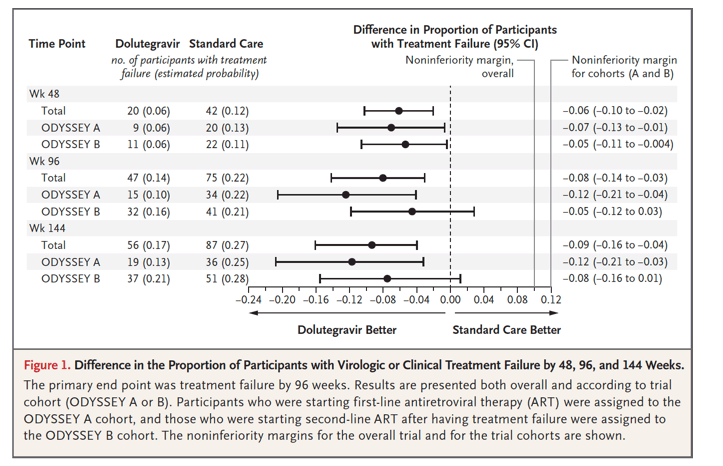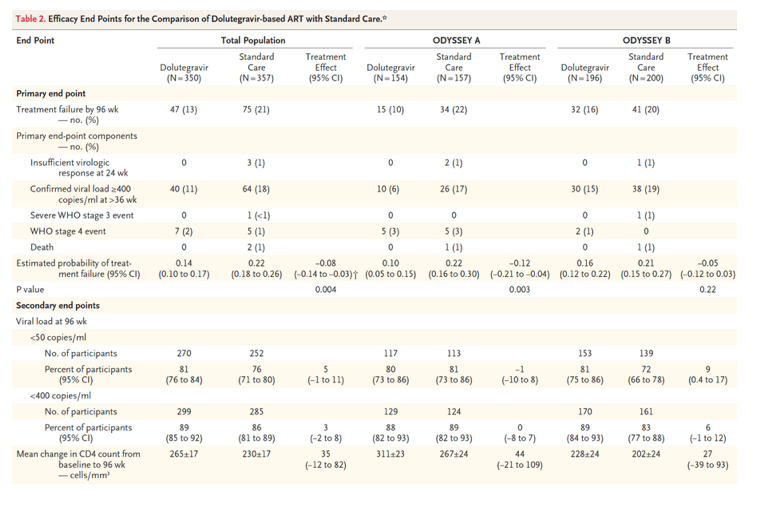| |
Dolutegravir as First- or Second-Line Treatment for HIV-1 Infection in Children
|
| |
| |
Dec 2021 anna Turkova et al
In 2018, while the ODYSSEY trial was ongoing, the WHO recommended dolutegravir-based ART as a preferred first- and second-line treatment for adults and children with HIV-1 infection18; recommendations for treatment in children were conditional, on the basis of low-certainty evidence. Nested ODYSSEY pharmacokinetic substudies provided evidence for updated simplified WHO guidance regarding doses, as well as FDA and EMA pediatric licensing recommendations in 2020.6,7 Once results from the pharmacokinetic substudies were available, participants in the dolutegravir group in our trial who weighed 20 to 40 kg moved from receiving 25 mg or 35 mg of dolutegravir (administered as 10-mg and 25-mg film-coated tablets, according to the initial doses approved by the FDA and EMA) to a single 50-mg film-coated tablet (intended for adults). These results made it possible for the majority of children living with HIV-1 infection worldwide to have expedited access to dolutegravir. In the trial follow-up, we saw no concerns about toxic effects in participants weighing 20 to 40 kg who were receiving the adult dose.
The randomized ODYSSEY trial showed evidence of the superior efficacy of dolutegravir-based ART, as compared with standard care, in children and adolescents starting first-line and second-line ART. The risk of treatment failure was approximately 40% lower with dolutegravir-based ART than with standard care. Superior efficacy was evident by 48 weeks, was sustained to 144 weeks, and was consistent across age, weight bands, and NRTI backbone therapies. No antiviral resistance was observed over a period of approximately 2 years in children and adolescents who started dolutegravir-based first-line ART, which suggests a higher barrier to INSTI resistance and protection against NRTI resistance than with mainly NNRTI-based first-line standard care. The occurrence of new INSTI resistance in 4 participants who received dolutegravir-based second-line ART highlights the need for ongoing adherence support among children and adolescents starting second-line treatment. Retention in the trial was excellent, and the incidence of treatment failure was low despite infrequent real-time viral-load monitoring in most participants and no requirement for resistance testing to guide the choice of NRTI backbone therapy for second-line treatment. Results are therefore generalizable across various settings, particularly in Africa, where most children with HIV-1 infection live.
Abstract
Background
Children with human immunodeficiency virus type 1 (HIV-1) infection have limited options for effective antiretroviral treatment (ART).
Methods
We conducted an open-label, randomized, noninferiority trial comparing three-drug ART based on the HIV integrase inhibitor dolutegravir with standard care (non-dolutegravir-based ART) in children and adolescents starting first- or second-line ART. The primary end point was the proportion of participants with virologic or clinical treatment failure by 96 weeks, as estimated by the Kaplan-Meier method. Safety was assessed.
Results
From September 2016 through June 2018, a total of 707 children and adolescents who weighed at least 14 kg were randomly assigned to receive dolutegravir-based ART (350 participants) or standard care (357). The median age was 12.2 years (range, 2.9 to 18.0), the median weight was 30.7 kg (range, 14.0 to 85.0), and 49% of the participants were girls. By design, 311 participants (44%) started first-line ART (with 92% of those in the standard-care group receiving efavirenz-based ART), and 396 (56%) started second-line ART (with 98% of those in the standard-care group receiving boosted protease inhibitor-based ART). The median follow-up was 142 weeks.
By 96 weeks, 47 participants in the dolutegravir group and 75 in the standard-care group had treatment failure (estimated probability, 0.14 vs. 0.22; difference, -0.08; 95% confidence interval, -0.14 to -0.03; P=0.004). Treatment effects were similar with first- and second-line therapies (P=0.16 for heterogeneity). A total of 35 participants in the dolutegravir group and 40 in the standard-care group had at least one serious adverse event (P=0.53), and 73 and 86, respectively, had at least one adverse event of grade 3 or higher (P=0.24). At least one ART-modifying adverse event occurred in 5 participants in the dolutegravir group and in 17 in the standard-care group (P=0.01).
Conclusions
In this trial involving children and adolescents with HIV-1 infection who were starting first- or second-line treatment, dolutegravir-based ART was superior to standard care. (Funded by ViiV Healthcare; ODYSSEY ClinicalTrials.gov number, NCT02259127. opens in new tab; EUDRACT number, 2014-002632-14. opens in new tab; and ISRCTN number, ISRCTN91737921. opens in new tab.)
A total of 47 participants had protocol-defined treatment failure by 96 weeks (estimated probability of treatment failure, 0.14) in the dolutegravir group, as compared with 75 participants (estimated probability, 0.22) in the standard-care group (difference, -0.08; 95% confidence interval [CI], -0.14 to -0.03; P=0.004) (Figure 1). Results were similar in the per-protocol analysis (difference in estimated probability, -0.07; 95% CI, -0.12 to -0.01) and in sensitivity analyses (Figs. S7.2 through S7.7). Among participants who met the primary end point, 40 in the dolutegravir group and 67 in the standard-care group had virologic treatment failure. Seven participants in the dolutegravir group and 8 in the standard-care group were categorized as having had treatment failure on the basis of a new or recurrent WHO stage 4 or severe WHO stage 3 event or death (Table 2). Treatment effects were similar in the ODYSSEY A and B cohorts (P=0.16 for heterogeneity) (Figure 1).
Among participants receiving first-line therapy (ODYSSEY A cohort), none of those in the dolutegravir group had a major drug-resistance mutation (as defined by the International AIDS Society) after treatment failure. Of 29 participants in the standard-care group who had virologic treatment failure by week 96 and had a post-treatment failure resistance test available for the drug class, 18 participants (62%) had NRTI-related mutations, 27 (93%) had NNRTI-related mutations, and none had protease inhibitor-related mutations; most of the mutations were new (Table 3).
Among participants receiving second-line therapy (ODYSSEY B cohort), 23 of 29 (79%) in the dolutegravir group and 36 of 40 (90%) in the standard-care group had at least one major mutation after treatment failure. Among participants who had exposure to the drug class, an INSTI-related mutation developed in 4 participants in the dolutegravir group (of whom 3 were receiving twice-daily zidovudine and lamivudine) and 2 had new NRTI mutations; in the standard-care group, 3 had new NRTI-related mutations, 2 participants had new NNRTI-related mutations, and 2 had new protease inhibitor-related mutations (Table 3 and S7.21).
Psychiatric events occurred in 10 participants in the dolutegravir group and in 4 in the standard-care group (adjusted hazard ratio, 2.48; 95% CI, 0.78 to 7.92; P=0.12). A total of 12 participants (8 in the dolutegravir group and 4 in the standard-care group) had suicidality events (suicidal ideation and attempts), including 5 suicide attempts (in 2 participants in the dolutegravir group and in 3 in the standard-care group).
Participants' weight, height, and body-mass index (BMI)-for-age z score increased more in the dolutegravir group than in the standard-care group (the BMI is the weight in kilograms divided by the square of the height in meters). The estimated between-group differences in means at 96 weeks were as follows: for weight, 1 kg (95% CI, 0.3 to 1.7); for height, 0.8 cm (95% CI, 0.2 to 1.4); and for the BMI-for-age z score, 0.13 (95% CI, 0.01 to 0.25). Details are provided in Tables S14.1, S14.4, and S14.7.
Adherence and quality-of-life assessments, as reported by participants or caregivers, were high and similar in the two treatment groups. Acceptability of the trial treatment was high overall, with few reported problems with taste or swallowing; there were marginally more such reports in the standard-care group than in the dolutegravir group. Details are provided in Tables S11.1 through S11.3.


|
|
| |
| |
|
|
|